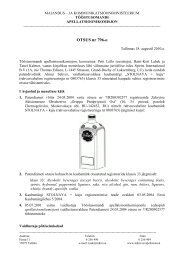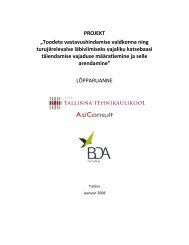Feasibility study for an Estonian Materials Technology Programme
Feasibility study for an Estonian Materials Technology Programme
Feasibility study for an Estonian Materials Technology Programme
You also want an ePaper? Increase the reach of your titles
YUMPU automatically turns print PDFs into web optimized ePapers that Google loves.
63<br />
<strong>Feasibility</strong> <strong>study</strong> <strong>for</strong> <strong>an</strong> Estoni<strong>an</strong> <strong>Materials</strong> <strong>Technology</strong> <strong>Programme</strong><br />
2. <strong>Materials</strong> technology in Estonia<br />
2.6 Education <strong>an</strong>d Hum<strong>an</strong> resources<br />
Higher level materials science <strong>an</strong>d technology education is carried out at all the universities in Estonia. More<br />
details about the universities c<strong>an</strong> be found in section 2.2.1. The relev<strong>an</strong>t education <strong>for</strong> each industry sector<br />
is mentioned under the industry sector reports in section 2.4. This section gives <strong>an</strong> overview of where the<br />
educated people go to work.<br />
The amount of employees working in research <strong>an</strong>d development in industry has steadily risen since 2007<br />
despite the economic downturn. The R&D personnel count in total in Estonia between 2007 <strong>an</strong>d 2009 was:<br />
2686 (2007), 3023 (2008) <strong>an</strong>d 3122 (2009). The effect of the economic downturn c<strong>an</strong> be seen in m<strong>an</strong>ufacturing<br />
industries where the size of R&D personnel dropped from 854 in 2007 to 663 in 2009. However, during<br />
the same period the amount of R&D personnel in comp<strong>an</strong>ies doing scientific research <strong>an</strong>d development more<br />
th<strong>an</strong> doubled from 304 in 2007 to 643 in 2009.<br />
This is due to the increase of scientific research <strong>an</strong>d development focused comp<strong>an</strong>ies as the share of doctoral<br />
degrees in R&D positions is 25% in these comp<strong>an</strong>ies (see Table 6). In the m<strong>an</strong>ufacturing industry, less th<strong>an</strong><br />
5% of R&D positions are fulfilled with doctors. The figures are similar when considering people with master’s<br />
degrees. 15% of R&D personnel in the m<strong>an</strong>ufacturing industry possess a Master’s degree whereas the figure is<br />
34% in scientific research <strong>an</strong>d development.<br />
Table 6 reveals that the current capabilities of implementing very high technology solutions in Estoni<strong>an</strong><br />
m<strong>an</strong>ufacturing industries are very limited due to the low number of highly educated work<strong>for</strong>ce (Doctor’s or<br />
Master’s).<br />
Table 6. The share <strong>an</strong>d amount of highly educated work<strong>for</strong>ce in different industry sectors in 2009<br />
Total Doctor's Master's Other<br />
Total 3122 274 688 2160<br />
M<strong>an</strong>ufacturing total 663 32 101 530<br />
Food 56 0 8 48<br />
Textiles 23 0 3 20<br />
Forest 26 0 6 20<br />
Chemicals 76 4 7 65<br />
Plastics 22 0 0 22<br />
Fabricated metal products 20 0 5 15<br />
Electronic <strong>an</strong>d electrical 244 20 45 179<br />
Machinery <strong>an</strong>d tr<strong>an</strong>sportation equipment 95 3 12 80<br />
Furniture 12 0 0 12<br />
Scientific R&D 643 161 221 261<br />
To be able to do <strong>an</strong>y kind of technology tr<strong>an</strong>sfer there has to be educated people to apply the new technology<br />
in a comp<strong>an</strong>y. Hum<strong>an</strong> resources are especially a challenge in materials technology as it is very research intensive<br />
<strong>an</strong>d underst<strong>an</strong>ding <strong>an</strong>d applying it requires a basic knowledge of the technology. Only after underst<strong>an</strong>ding<br />
the technology c<strong>an</strong> it be further developed – either alone in the comp<strong>an</strong>y or together with the university.<br />
Un<strong>for</strong>tunately, even on Europe<strong>an</strong> scale the number of students <strong>study</strong>ing materials technology is decreasing<br />
<strong>an</strong>d ef<strong>for</strong>ts have to be done to keep it competitive with the other more modern subjects. Universities in<br />
Estonia are also facing the problem of having too m<strong>an</strong>y drop-out students. The current solution to the problem<br />
is a decrease in the yearly intake of students. Another possible solution could be to make the education<br />
more relev<strong>an</strong>t to current <strong>an</strong>d future industry needs <strong>an</strong>d increase the in<strong>for</strong>mation exch<strong>an</strong>ge between universities<br />
<strong>an</strong>d the industry.<br />
In all but two of the interviewed cases most of the PhDs were employed by universities, this was especially true<br />
with the more traditional fields of materials science such as metals <strong>an</strong>d machinery. To benefit the society <strong>an</strong>d<br />
comp<strong>an</strong>ies at least a small portion of PhD studies should be done in cooperation with comp<strong>an</strong>ies or based on<br />
comp<strong>an</strong>y needs. Interviews also suggest that it is difficult to find university students with business sense, one<br />
thing that could be added to the curricula or obtained from internships in comp<strong>an</strong>ies.





